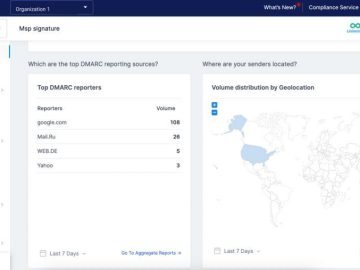Listen
NEW! Listen to article
Sign in or sign up to access this audio feature! No worries … it’s FREE!
Email deliverability can feel out of your control. That’s especially true for B2B brands, which have traditionally struggled with the mercurial spam-filtering behaviors of corporate email servers and the IT overlords that control them.
However, now that Google Workspace and Outlook 365 are making serious inroads into the corporate email market, B2B email deliverability is behaving more like deliverability for B2C brands.
That means inbox placement—i.e., reaching the inbox of recipients—is increasingly unifying around seven core email deliverability factors:
- Infrastructure: The servers, setup, and controls used by a company’s email service provider (ESP) are important, as is authentication (SPF, DKIM, and DMARC).
- Volume: The higher your email volume and the more erratic your sending patterns, the more scrutiny you can expect from mailbox providers.
- Email content: Instead of worrying about word choice, punctuation, and the balance of images and text in your emails, you need to ensure your email code is safe and clean, and that you’re not linking to websites with poor reputations.
- Bounces and spam traps: Brands want to keep their hard bounce rates at 2% or under and avoid adding spam traps to their mailing lists.
- Spam complaints: If more than 0.1% of a brand’s subscribers report its emails as spam, the brand may experience blocking or anti-spam junking.
- Engagement: Mailbox providers want to see senders’ subscribers opening, clicking, and otherwise engaging with their emails.
- Reputation: Each mailbox provider uses its own unique and secret weighting of the other six factors and their subfactors to create a reputation for each sender, which the provider attaches to the IP addresses as well as the website domains used by the sender.
With those factors in mind, let’s talk about the unique behaviors of B2B brands that are the most likely to cause their emails to be blocked or end up in the junk folder—which can be expensive when you count opportunities lost and deliverability remediation costs.
1. B2B marketers are more likely to buy email lists
If you look at how many companies are pushing such services, B2B brands can be somewhat excused for thinking it’s OK. I get at least one unsolicited email a day from a company trying to get me to buy a list.
Though sadly not yet illegal in the US, buying email lists puts you at high risk of…
- Spam complaints, because you can’t buy permission
- Hard bounces, because people leave companies and their email addresses are deactivated
- Spam traps, because less reputable list-sellers use email address harvesting software, which also sweeps up pristine spam traps placed on the Internet by blocklisting organizations and mailbox providers to help identify spammers
2. B2B marketers are more likely to ‘rent’ lists for email campaigns
I put “rent” in quotation marks because many list-sellers have rebranded themselves as list rental companies: They know that selling email addresses is frowned upon by many. There’s nothing wrong with doing a true list rental, if you stick to the following principles:
- At no point do you as the list-renter see a list-owner’s list. Owners should only share list size, demographic, and other information about the audience.
- List-renters craft the message. List-owners approve or reject the message, or ask for revisions.
- List-owners send that message to their subscribers using their email service provider.
- The message is sent with the list-owners’ sender name, header, and logo at the top of the email, because they are vouching for your company being relevant to their audience.
- The message is sent with the list-owners’ unsubscribe link, so they suffer the unsubscribes if your message isn’t a good fit for their audience.
If a list-owner is unwilling to abide by those precepts, you should look elsewhere, as it’s a sign that your message is not a good fit for the list-owner’s audience—or that the audience itself is of very low value.
3. B2B marketers tend to have more widely distributed subscriber acquisition practices
At B2B companies, new leads and subscribers are sometimes collected by individual sales team members. That makes enforcing standards around permission much harder, which can lead to low engagement levels and high hard-bounce numbers and spam complaints.
For example, sometimes salespeople will add the email address of someone they connected to on LinkedIn, mistaking permission to reach someone on that channel with permission to reach them via email. Having email address collection quotas can make the process even riskier, driving up complaints and hard bounces.
4. B2B marketers are more likely to have rogue distribution lists
Sometimes sales team members get their own email service provider accounts, so they nurture their own leads separate from what the organization is doing. In addition to losing control of the brand’s messaging and cadence, such practices should concern B2B brands because the spam complaints generated by those emails can harm its website domain reputation—and therefore its sender domain (IP) reputation.
If you haven’t ever done so (or it’s been a while), use a tool such as SparkPost’s eDataSource or Oracle’s Deliverability Plus to identify all the IP addresses and email service providers that are sending email on behalf of your brand. Chances are you’ll be shocked by what you find.
5. During normal times, B2B marketers are more likely to grow their lists at in-person events
Although events are a great place to attract high-quality subscribers, it’s one of the last places where paper forms are used. That invariably leads to transcription errors, which causes high bounce rates. Using tablets with opt-in forms drastically reduces that risk.
Permission collection also tends to get murky at events.
“Just because people visit your booth, have their badge scanned, and put their business card in for your raffle doesn’t mean they opted in to receive your promotional emails,” says Cristal Foster, head of list growth and demand generation services at Oracle Marketing Consulting.
“There are major disconnects between what B2B marketers think should happen next and what those prospects expect. Event staff need to do a much better job of collecting informed consent. Currently, it’s a lot of assumed consent.”
6. B2B marketers often use report download forms and webinar registration forms for lead generation
Sometimes registration forms contain prechecked opt-in boxes or consent buried behind a “terms of use” link. Practices like those, especially the latter, lead to high spam complaints.
Poor transparency around opt-in practices can also lead more people to enter a secondary email address that they don’t check often or, even worse, a temporary email address or Hide My Email address that hard-bounces after a short time.
* * *
The biggest challenge for B2B email deliverability is to get all marketers, salespeople, event staff, and other employees to understand how their tactics and actions affect a company’s sender reputation.
Event staff probably don’t understand that poorly captured email addresses hard-bounce and hurt email deliverability; likewise, salespeople probably don’t understand that they harm the reputation of their company’s domain when they start their own shadow marketing program.
A little education can go a long way in helping employees understand that they all have a role in maintaining the company’s inbox placement.
More Resources on Email Deliverability
What Every Marketer Needs to Know About Email Deliverability
Email Deliverability Rates Dragging You Down? Try These 10 Do’s and 7 Don’ts
Five Email Deliverability Myths Debunked




